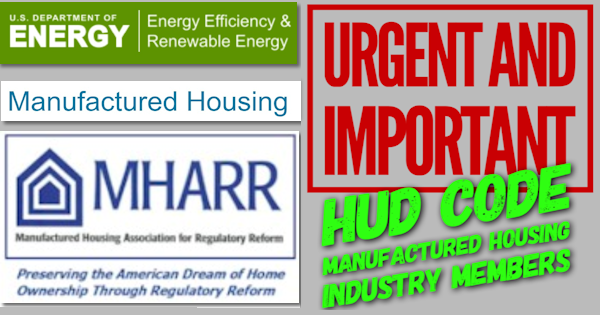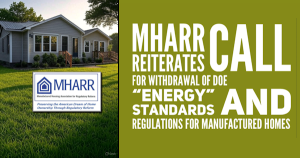URGENT and IMPORTANT Notice to HUD Code Manufactured Housing Industry Members

URGENT AND IMPORTANT
MAY 18, 2022
TO: HUD CODE MANUFACTURED HOUSING INDUSTRY MEMBERS
FROM: MHARR
RE: DOE RELEASES FINAL MH ENERGY STANDARDS RULE
Within two days of the Biden Administration’s widely-proclaimed announcement of various “administrative actions to ease the burden of housing costs,” the U.S. Department of Energy (DOE) has released the “pre-publication” version of a final rule for manufactured housing “energy conservation” standards (copy attached) that will drastically increase the cost of the nation’s most affordable housing and simultaneously exclude millions of Americans from the manufactured housing market and from homeownership altogether. Based on the 2021 version of the International Energy Conservation Code (IECC), the DOE final standard will discriminatorily subject HUD Code manufactured homes and the lower and moderate-income Americans who rely on them, to energy standards more stringent and more costly than those applied to million-dollar site-built homes.
The 354-page rule released today by DOE will apparently retain elements of the “tiered” structure initially outlined in the Department’s August 26, 2022 proposed rule, notwithstanding DOE’s stated intent, as set forth in its final April 2022 Environmental Impact Statement (EIS), to switch to an “untiered” approach as the “primary” scenario for the final rule. Industry members will recall that in a May 4, 2022 communication to DOE Secretary Jennifer Granholm, MHARR had vehemently objected to such a “bait and switch” tactic after the conclusion of any opportunity for public comment.
As published, the compliance date for the new standards will nominally be one year after the date of publication of the final rule in the Federal Register. This, along with multiple other aspects of the new rule, represents a direct rebuke of HUD’s Manufactured Housing Consensus Committee (MHCC), which had, among other things, recommended a much longer phase-in of the new standards over a five-year period.
Put simply, the publication of this discriminatory and unnecessary edict – which MHARR has opposed and has been fighting since day-one – should be a call to arms for the entire industry. As MHARR has consistently demonstrated, the direct cost impacts of this standard and its related regulatory and compliance-related costs, will drive millions of Americans out of the manufactured housing market and deprive them of the opportunity to achieve the American Dream of homeownership altogether. This despite the fact, again as demonstrated by MHARR, that manufactured housing energy operating costs are already lower than those for site-built homes left untouched by the 2021 IECC.
Most fundamentally, with the publication of the final energy standard, the industry finds itself at a cross-roads. While MHARR has attempted to get ahead of this issue by supporting a group of states in a court challenge to the use of the Social Cost of Carbon (SCC) metric in connection with this and other federal regulations, and while a favorable decision in that case could still potentially impact the DOE rule, the industry now faces a direct and arguably existential challenge. Put simply, a discriminatory imposition on the industry and its consumers, such as the final DOE rule, cannot stand and must not be allowed to take effect without a specific, focused, and concerted challenge. It will be up to the industry, therefore, to meet that challenge and, as necessary, pursue a two-track strategy of opposition to prevent the decimation of the manufactured housing market through such baseless and unnecessary regulation.
MHARR is in the process of reviewing the final pre-publication rule, and will address the rule and issues relating to its adoption and attempted imposition in the near future.

URGENT AND IMPORTANT
MAY 18, 2022
TO: HUD CODE MANUFACTURED HOUSING INDUSTRY MEMBERS
FROM: MHARR
RE: DOE RELEASES FINAL MH ENERGY STANDARDS RULE
Within two days of the Biden Administration’s widely-proclaimed announcement of various “administrative actions to ease the burden of housing costs,” the U.S. Department of Energy (DOE) has released the “pre-publication” version of a final rule for manufactured housing “energy conservation” standards (copy attached) that will drastically increase the cost of the nation’s most affordable housing and simultaneously exclude millions of Americans from the manufactured housing market and from homeownership altogether. Based on the 2021 version of the International Energy Conservation Code (IECC), the DOE final standard will discriminatorily subject HUD Code manufactured homes and the lower and moderate-income Americans who rely on them, to energy standards more stringent and more costly than those applied to million-dollar site-built homes.
The 354-page rule released today by DOE will apparently retain elements of the “tiered” structure initially outlined in the Department’s August 26, 2022 proposed rule, notwithstanding DOE’s stated intent, as set forth in its final April 2022 Environmental Impact Statement (EIS), to switch to an “untiered” approach as the “primary” scenario for the final rule. Industry members will recall that in a May 4, 2022 communication to DOE Secretary Jennifer Granholm, MHARR had vehemently objected to such a “bait and switch” tactic after the conclusion of any opportunity for public comment.
As published, the compliance date for the new standards will nominally be one year after the date of publication of the final rule in the Federal Register. This, along with multiple other aspects of the new rule, represents a direct rebuke of HUD’s Manufactured Housing Consensus Committee (MHCC), which had, among other things, recommended a much longer phase-in of the new standards over a five-year period.
Put simply, the publication of this discriminatory and unnecessary edict – which MHARR has opposed and has been fighting since day-one – should be a call to arms for the entire industry. As MHARR has consistently demonstrated, the direct cost impacts of this standard and its related regulatory and compliance-related costs, will drive millions of Americans out of the manufactured housing market and deprive them of the opportunity to achieve the American Dream of homeownership altogether. This despite the fact, again as demonstrated by MHARR, that manufactured housing energy operating costs are already lower than those for site-built homes left untouched by the 2021 IECC.
Most fundamentally, with the publication of the final energy standard, the industry finds itself at a cross-roads. While MHARR has attempted to get ahead of this issue by supporting a group of states in a court challenge to the use of the Social Cost of Carbon (SCC) metric in connection with this and other federal regulations, and while a favorable decision in that case could still potentially impact the DOE rule, the industry now faces a direct and arguably existential challenge. Put simply, a discriminatory imposition on the industry and its consumers, such as the final DOE rule, cannot stand and must not be allowed to take effect without a specific, focused, and concerted challenge. It will be up to the industry, therefore, to meet that challenge and, as necessary, pursue a two-track strategy of opposition to prevent the decimation of the manufactured housing market through such baseless and unnecessary regulation.
MHARR is in the process of reviewing the final pre-publication rule, and will address the rule and issues relating to its adoption and attempted imposition in the near future.












